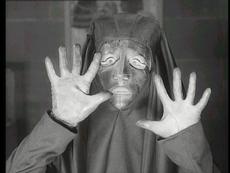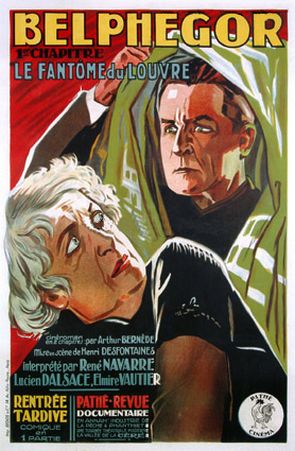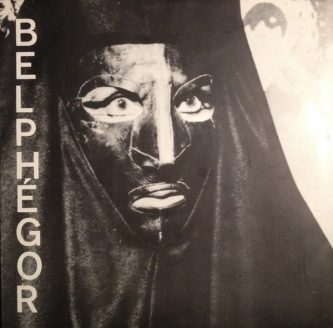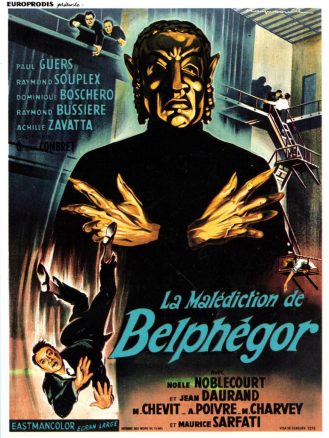 BELPHEGOR is a horrific crime saga whose origins can be traced back to 1909. It was then that the iconic FANTOMAS series of pulp novels were instituted by Marcel Allain and Pierre Souvestre, followed in 1914 by the equally revered Louis Feuillade helmed FANTOMAS film serial. Those novels and films inspired a wealth of like-minded accounts in FANTOMAS’ native France, including TENEBRAS, MASQUE ROUGE, DEMONAX and Feuillade’s own JUDEX. Most are forgotten now, but there is one FANTOMAS knock-off that has endured.
BELPHEGOR is a horrific crime saga whose origins can be traced back to 1909. It was then that the iconic FANTOMAS series of pulp novels were instituted by Marcel Allain and Pierre Souvestre, followed in 1914 by the equally revered Louis Feuillade helmed FANTOMAS film serial. Those novels and films inspired a wealth of like-minded accounts in FANTOMAS’ native France, including TENEBRAS, MASQUE ROUGE, DEMONAX and Feuillade’s own JUDEX. Most are forgotten now, but there is one FANTOMAS knock-off that has endured.
The so-called “Phantom of the Louvre,” Belphegor’s moniker derives from a demon statue found in the Louvre museum’s Room of the Barbarian Gods. This phantom’s longevity stems, I believe, from the simple fact that it’s such a striking sight: a hooded figure wearing a creepy tribal mask who appears at night, using a succession of hidden doors and passageways to do his/her nefarious work.
BELPHEGOR was actually one of the later entries in the FANTOMAS knock-off craze, debuting simultaneously as a novel  and four-part silent film serial in 1927. By that point the popularity of the serial format had long since peaked, and indeed the entire silent era was nearly at an end, which may explain why the BELPHEGOR serial has fallen into obscurity. The novel, on the other hand, has proven surprisingly resilient: it was solely credited with inspiring BELPHEGOR’S later incarnations, and is currently available in no less than two English translations (from Creation and Black Coat Press). I find that odd, as the novel is the lesser of the two entities. The serial is at least lively and diverting, while the text is serviceable at best, making the famously slapdash FANTOMAS books look artful and nuanced in comparison.
and four-part silent film serial in 1927. By that point the popularity of the serial format had long since peaked, and indeed the entire silent era was nearly at an end, which may explain why the BELPHEGOR serial has fallen into obscurity. The novel, on the other hand, has proven surprisingly resilient: it was solely credited with inspiring BELPHEGOR’S later incarnations, and is currently available in no less than two English translations (from Creation and Black Coat Press). I find that odd, as the novel is the lesser of the two entities. The serial is at least lively and diverting, while the text is serviceable at best, making the famously slapdash FANTOMAS books look artful and nuanced in comparison.
The author and screenwriter was Arthur Bernede, whose previous credits included JUDEX and VIDOCQ (both of which appeared in similar book-film combos in 1917 and 1922, respectively), the latter of which starred Rene Navarre, a FANTOMAS alum who also headlined the BELPHEGOR serial. Directed by Henri Desfontaines, that serial isn’t perfect, expending as it does an ungainly three and a half hour running time on rather trite B-movie material, and nor does it have the idiosyncratic charge of Louis Feuillade, whose brand of pulpy commercialism appears to have been the overriding influence. Furthermore, the performances are uneven, running the gamut from admirably restrained to wildly histrionic.
As in FANTOMAS we have a seemingly supernatural criminal who hides his identity while taunting authorities, opposed by-–also as in FANTOMAS–-a dogged lawman-news reporter team: the “King of Detectives” Chantecoq and Bellegarde (Lucien Dalsace), a newsman falsely accused of being Belphegor. As played by Mr. Navarre, Chantecoq is a rather bland personage who aside from hiding the disgraced Bellegarde and eventually exposing Belphegor’s identity does very little. As for Belphegor, his/her intent is to steal a treasure secreted in the bowels of the Louvre by the Medici family, and isn’t above tracking down and killing anyone who might get in his/her way.
The film is quite entertaining overall, and notable for its haunting presentation of the title character, who turns up in a creepy bit set in the caverns below the Louvre, and also as a spectral presence in a striking hallucinatory interlude. Also striking are brief flashbacks of Catherine de Medici, and the climax in which Belphegor’s identity is revealed, which was apparently quite a shocker in its day.
 From there Belphegor disappeared for nearly forty years. But, proving it’s impossible to keep a good character down, BELPHEGOR returned, and reached its undoubted apotheosis in a form that seems the closest modern equivalent to the film serials of old: a TV miniseries. That four part series, one of the most widely viewed French programs of its time, has attained near-legendary status in its native land yet remains quite obscure in the rest of the world. This mirrors the status of French miniseries overall, a most interesting and vital format that (unlike much of France’s late 20th Century filmic output) is quite genre-friendly, and has provided some laudable work—see 1973’s LA DUCHESSE D’AVILA and 1976’s LA POUPEE SANGLANTE—but remains little known outside France.
From there Belphegor disappeared for nearly forty years. But, proving it’s impossible to keep a good character down, BELPHEGOR returned, and reached its undoubted apotheosis in a form that seems the closest modern equivalent to the film serials of old: a TV miniseries. That four part series, one of the most widely viewed French programs of its time, has attained near-legendary status in its native land yet remains quite obscure in the rest of the world. This mirrors the status of French miniseries overall, a most interesting and vital format that (unlike much of France’s late 20th Century filmic output) is quite genre-friendly, and has provided some laudable work—see 1973’s LA DUCHESSE D’AVILA and 1976’s LA POUPEE SANGLANTE—but remains little known outside France.
As in the original BELPHEGOR the miniseries features a mask-and-cape wearing freak terrorizing the Louvre museum, although the modus operandi is far different from the treasure hunt of the 1927 book and film. Here Belphegor’s motives are more esoteric, involving alchemy and hypnosis.
A far greater change wreaked on the material is the absence of the “King of Detectives,” in whose place is the more down-to-Earth police commissioner Menardier (Rene Dary), whose daughter Collette (Christine Delaroche) romances Bellegarde (Yves Renier), rendered here as an overly inquisitive youngster. It’s Bellegarde who stumbles upon the evil machinations of the title character. He also embarks on a reckless affair with a mysterious seductress named Laurence (Juliette Greco), who, needless to add, has a definite connection with Belphegor—not to mention a twin sister named Stephanie, who has her own connection with the madness.
In their various tweaks and additions to the material the screenwriters of this miniseries have succeeded in both tightening up and broadening out the narrative of BELPHEGOR. It’s all extremely well orchestrated by director Claude Barma, who gives the proceedings a notably measured pace that’s directly at odds with the type of filmmaking in vogue today. Barma also pulls off some terrific action/suspense sequences, most notably an ingeniously conceived Hitchcockian bit in which Bellegarde is a tied to the front of a train car in the middle of a busy train yard, and a breakneck foot chase through an automobile junkyard.
Belphegor made further appearances over the years, and in various media. 1967’s LA MALEDICTION DE BELPHEGOR  (THE CURSE OF BELPHEGOR) was a poorly received feature film cash-in on the mini-series. It followed BELPHEGOR SE VENGE (BELPHEGOR’S REVENGE), a 24-episode comic strip co-scripted by Claude Barma in 1965. There was also a 26-episode animated BELPHEGOR TV series in 2001 and, unfortunately enough, an appalling in-name-only feature film remake of BELPHEGOR that appeared the same year.
(THE CURSE OF BELPHEGOR) was a poorly received feature film cash-in on the mini-series. It followed BELPHEGOR SE VENGE (BELPHEGOR’S REVENGE), a 24-episode comic strip co-scripted by Claude Barma in 1965. There was also a 26-episode animated BELPHEGOR TV series in 2001 and, unfortunately enough, an appalling in-name-only feature film remake of BELPHEGOR that appeared the same year.
Directed by Jean-Paul Salome, the 2001 BELPHEGOR takes the overall concept of its predecessors–a phantom in the Louvre—and turns it into an altogether ridiculous special effects-heavy blur. Sophie Marceau plays a young woman living near the Louvre who becomes possessed by an evil spirit bequeathed by artifacts from an archeological dig in Egypt; in this guise Marceau dresses up as the Belphegor we known and love and haunts the Louvre.
Somehow the filmmakers managed to convince the notoriously reclusive Julie Christie to appear in the film, which remains the most impressive aspect of this thoroughly clichéd and overwrought production. With its overdose of substandard CGI, MTV-worthy pacing and conclusion that shamelessly portends a sequel, the film appears to have been inspired as much by the 1999 MUMMY as the previous BELPHEGORS.
Regarding future incarnations of the Phantom of the Louvre, there don’t appear to be any on the horizon (yet). The 2001 BELPHEGOR failed to attain the massive success for which it was so clearly groomed—its overpowering commercialism suggests its makers intended to crack the US market, something the film never managed to achieve—which put an end to BELPHEGOR’S reign. Belphegor deserves credit, though, for casting a 75-year spell with an illumination that has yet to fade.
